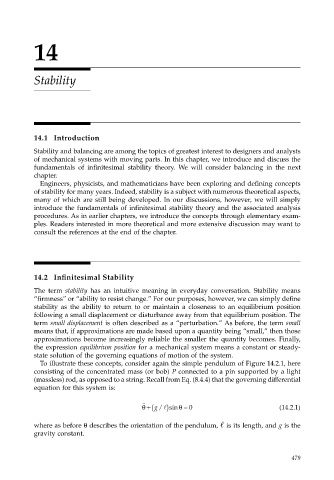Page 498 - Dynamics of Mechanical Systems
P. 498
0593_C14_fm Page 479 Tuesday, May 7, 2002 6:56 AM
14
Stability
14.1 Introduction
Stability and balancing are among the topics of greatest interest to designers and analysts
of mechanical systems with moving parts. In this chapter, we introduce and discuss the
fundamentals of infinitesimal stability theory. We will consider balancing in the next
chapter.
Engineers, physicists, and mathematicians have been exploring and defining concepts
of stability for many years. Indeed, stability is a subject with numerous theoretical aspects,
many of which are still being developed. In our discussions, however, we will simply
introduce the fundamentals of infinitesimal stability theory and the associated analysis
procedures. As in earlier chapters, we introduce the concepts through elementary exam-
ples. Readers interested in more theoretical and more extensive discussion may want to
consult the references at the end of the chapter.
14.2 Infinitesimal Stability
The term stability has an intuitive meaning in everyday conversation. Stability means
“firmness” or “ability to resist change.” For our purposes, however, we can simply define
stability as the ability to return to or maintain a closeness to an equilibrium position
following a small displacement or disturbance away from that equilibrium position. The
term small displacement is often described as a “perturbation.” As before, the term small
means that, if approximations are made based upon a quantity being “small,” then those
approximations become increasingly reliable the smaller the quantity becomes. Finally,
the expression equilibrium position for a mechanical system means a constant or steady-
state solution of the governing equations of motion of the system.
To illustrate these concepts, consider again the simple pendulum of Figure 14.2.1, here
consisting of the concentrated mass (or bob) P connected to a pin supported by a light
(massless) rod, as opposed to a string. Recall from Eq. (8.4.4) that the governing differential
equation for this system is:
)
˙˙ θ +(g / sinθ = 0 (14.2.1)
l
where as before θ describes the orientation of the pendulum, is its length, and g is the
gravity constant.
479

